A couple years ago I played around with trying to distill M-State material from Dead Sea Salt and Celtic Sea Salt. I’d read the David Hudson lectures a number of times and searched the web for any sources that might have reproduced what David discovered.
One of the sources I came across was the website SubtleEnergies.com. After digging around a bit there, I found the Wet-Method Procedure for isolating M-State from these salts. The procedure can be found here.
I don’t know how many times I read it in order to build the confidence that I could actually perform this ‘science.’ But eventually, I got to that point and gathered the equipment. Figuring that it would be pretty important to follow the directions carefully, I saved a few bucks and acquired a collection of beakers, eye droppers and even a pH meter. The collection turned out to be very similar to this kit found on Amazon:
I think I might have collected a couple more standard beakers and a stand, but that’s pretty close. The pH meter was similar to this:
After reading a bunch of sites and seeing that the directions were all very similar, I figured that the directions that I found were ‘good enough’ for me to get the job done.
Then, I set out to follow the instructions explicitly.
To sum up a couple months worth of testing, I never got to what I felt was M-State material. I remember coming across a statement from David Hudson that the material was like cow sperm (he had a farming background) or a gelatinous concoction. All I came up with was a milky white substance.
After searching around a bit, I found the following information from a David Hudson lecture:
When mixed with water WPG forms a gelatinous mixture. When ingested it has the following affects. “Every cell in your body will be taken back to the state it is supposed to be, when you were a teenager or a child. It perfects the DNA, and closes the light within the body until you literally reach a point where the light body exceeds the physical body.”
It left me a little discouraged. So, I packed up the chemistry set and figured I’d wait until the time was right and keep my eyes open.
Well, it just so turns out that I stumbled across a video on YouTube where it looks like HealingMindN is able to get to the point that I wanted to get to. Here is his video (also shown below). If you’ve been looking for a good video on the wet-method M-State distillation process, this might be it.
Special note: when watching the video, he adds music about 2:23 in. Fortunately, he’s funneled it to the one speaker and his voice is on the other. If you want to hear him without the interference, just turn off the speaker playing the music and turn up the other.
Here are the steps as outlined by the video. I’ve made a few screen shots with the idea of lining up the wet-method with what it is that HealingMindN shows.
Let’s start.
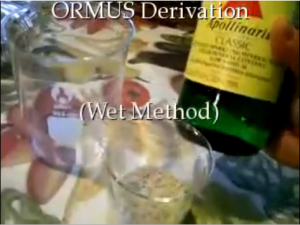
Mineral water. Turns out he’s bought a German import, Apollinaris water. A quick search on the net finds an Amazon source. Search Amazon for product number: 030494881229.
He claims that it contains Magnesium which will be a good catalyst for the process. And, if you look around the web a bit more, you’ll find AquaMaestro which has a great writeup:
Apollinaris is a naturally carbonated mineral water renowned for its health and curative powers. Although not tremendously high in Calcium compared with many other curative brands, Apollinaris it is strong in Potassium, and Sulphate, and gangbusters in Magnesium and Bicarbonate at 130 milligrams and 1810 milligrams per liter respectively. What you might not like is the Sodium – also extremely high at 410 milligrams (almost a half a gram) per liter. And, it must be noted that we have not ascertained the all-important Nitrate level. …
So, that part holds up. In any case, he claims that 2 cups distilled water plus 1 teaspoon of Epsom salts may be substituted if the water is not found (video 00.15).
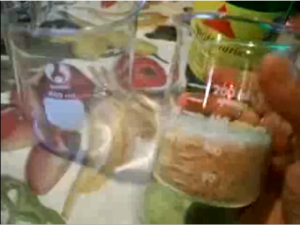
Half cup Celtic Sea Salt. That stuff looks like this (above). Search Amazon for product number: B000SWVPV8.
You can probably find that in your local health food store. The CelticSeaSalt website has a write-up about it that reads:
Celtic Sea Salt® Brand Light Grey Celtic® is totally unprocessed, kosher and hand harvested. It is dried by the sun and the wind, retaining the ocean’s moisture and locking in a vast array of vital trace elements. Celtic Sea Salt® Light Grey Celtic® is a coarse, moist salt that gets a light grey hue from the pure clay sole it is harvested from. There is no comparison, in taste or in health effects, between mineral-rich Celtic Sea Salts® and chemically-treated iodized salts. …
And, again, HealingMindN suggests that other sea salts may be substituted such as Lima Atlantic or Dead Sea Salt.
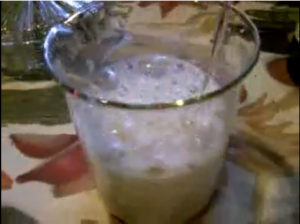
I believe he’s saying that he’s adding 450 milliliters to the beaker too which he adds the salt. After stirring for a moment, it sounds like he says he’s going to let it sit overnight.
Great. That is a step that I do not remember from the Wet-Method procedure written up at SubtleEnergies. Yet, maybe it doesn’t have to sit overnight.
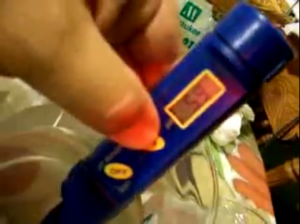
Looks like the starting pH of the salt water is 5.9.

And now for his setup – food grade lye water. Looks like he’s using Tropics Lye Water. Turns out that Amazon also shows this product.
He claims it’s about 12.7 pH. Anyone should be able to validate that pretty easily. It looks like at second 2:10 in the video, he’s got 140 milliliters of Lye Water that he’ll be using.
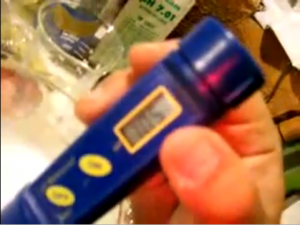
Looks like he continues to add the lye solution until the Sea Water hits 10.5. He points out that it is point 1 to go from stop. Thus, he’s looking for 10.6 as the stopping point for this pH swing.
(Editors note: The lye mixture is an 8:1 mixture. Add 8 parts water to a beaker and then slowly, in a vented area, add the other 1 part lye crystals while stirring careful not to overheat. This information can be found by digging around a bit on the SubtleEnergies site or visiting the OrmusBook. There, I quote from the FAQ section:
…For the processes detailed in the book, a 1:8 strength works very, very well. That is ½ cup of lye (NaOH) crystals mixed as described in the book into 1 quart of distilled water. This would be about 125 grams per liter of water in the metric system.
Yet you don’t need that much for these small volumes. A 1:8 mixture would be 25 millileters lye to 200 milliliters distilled water. )
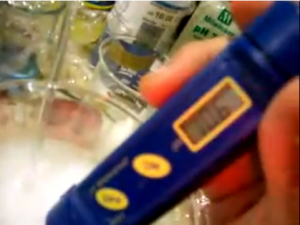
At 3:17 in the video, The participate has formed, it’s mainly Magnesium Hydroxide Lye … and a little M-State. He is now at pH 10.6.
Overall, he’s added about 140 milliliters of lye just like he did last time and he’s going to let it sit overnight. So that it settles.
He makes a comment to not use anything but glass so as to not disrupt the M-State material.
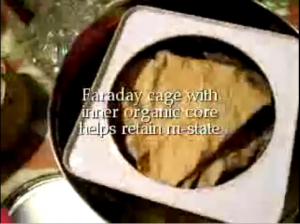
Here, he shows his Faraday cage that he uses to place the M-State material in overnight. His faraday cage is two cookie containers where the center one is lined with steel wool where there is a brown paper bag inside of that. His participate container has cellophane with a rubber band holding it on.
It might be work investigating this a little more. If M-State is sensitive to electromagnetic energy, shielding it might be a good idea. Yet, I’m not sure how well his box is working, for one of the key elements of a Faraday cage is grounding. Yet, let’s continue.

He shows about 300 milliliters of precipitate and the covering liquid has a pH of about 10.4.
He comments that he’s going to wash the precipitate three times.
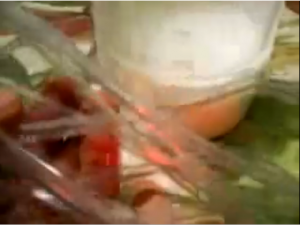
Here he shows the plastic tubing that he’s going to use to remove the liquid on top of the precipitate.
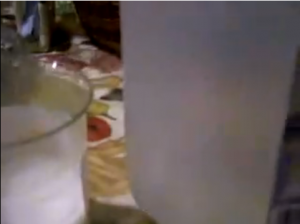
Here we can almost see the brand of distilled water that he’s going to use to water the precipitate. He fills the container up to about 600 milliliters again so that he can let it settle again overnight.
At this point I have to assume that he goes through the washing process all three times before coming back to the video. Thus, at this point, he’s just about doubled the water content in his beaker three times and removed the substrate covering the precipitate as he outlined. If he lets it settle overnight each time, a few days have passed.
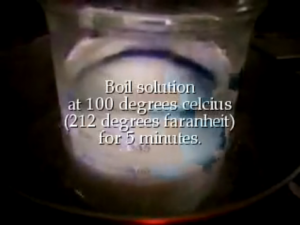
He then jumps straight into the boiling process. We can see from his text that he boils for 5 minutes.

Here he shows the precipitate after boiling and he’s going to take it to pH 12. He stated that last time it took nearly 50 milliliters of Lye water to perform that task.
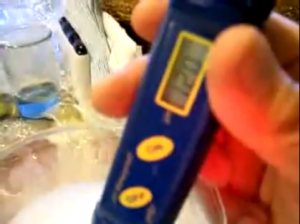
Here he shows that he’s raised the pH to 12.0. At this point, the M-State will be re-dissolved in solution. Shortly after showing the pH, he comments that he should have drained off more substrate (the clear liquid on top) for he recognizes that he has more volume than what he was expecting.
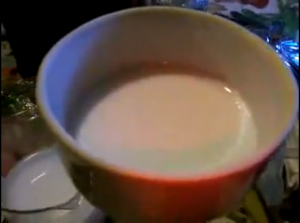
Here we see the filter that he’s going to use to remove the precipitate leaving just the clear liquid holding the M-State material.
At this point, I wish I knew what that filter was. I’ve searched around on some different chemistry supply websites, but when you don’t know what you’re looking for, it makes things a little harder to find. Hopefully, I’ll find a picture that matches what he’s using.
(Author’s note: Ask and you shall receive. As it turns out, I now have a better idea what this filter is. Turns out OnlineScienceMall has a number of different sizes to choose from. They call them Filtration Assemblies. Follow the link and the picture will really sum it up.)
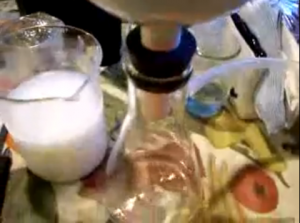
Here is a good picture showing his flask with the rubber stopper holding the funnel filter. What gathers in the flask (the filtrate) is what he’s looking for.

Here he shows the pH of the filtrate. He comments that it’s gone down a little to 11.8.
At this point, he mentions something like “from here on out it’s a feeling out process as the ‘coopers pairs’ start forming in solution they start congealing just like making gelatin.”
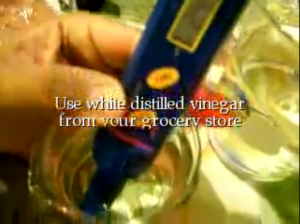
Now he goes to bring the solution down to 10.78 pH. He uses acetic acid. The form of the acid is white distilled vinegar that you’d find in the grocery store. During this process, the ‘coopers pairs’ should start forming.
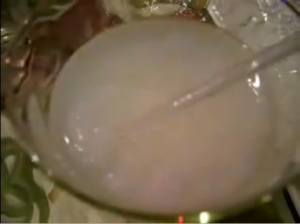
Here he shows nice big globules of M-State ‘Jello.’
After watching this video, it seems pretty simple. I just might have to give it another try.
The only question that I have is about the filtering process. Looks like HealingMindN is using a filter flask, but I can’t find the actual filter online. I’ll have to keep looking and see what I can find. If I can come up with that final setup, then I’ll give it another try. (See comment above for a link to filtration assembles.)
As a point of reference, I’ve included the process form SubtleEnergies.com below. The steps are nearly identical. The only real difference comes at the end when HealingMindN mentions that it’s a feeling out process from here on out.
Wet Method Procedure.
If you are using dried sea minerals, mix 1/2 cup of dry material with 2 cups of distilled water. This makes sea water. Now proceed as described below:
1. First, you might want to pour the sea water through a coffee filter to remove any scum.
2. If the starting material does not contain magnesium hydroxide (sea water does contain magnesium hydroxide), add some, or add a teaspoon of Epsom salts per gallon of water.
3. Pour the sea water into a stainless steel pot. Slowly, drop-by-drop, add the lye solution WHILE STIRRING. Every ten drops or so, test the pH. You might want to take at least 3 to 5 samples from different regions of the liquid. If you are using pH paper, the goal is to bring the pH up to 9.5, then stop to be on the safe side. If you are using a pH meter, stop just before you get to pH 10.78.
A white precipitate which includes m-state elements will form.
CAUTION: You must proceed slowly and patiently so that you do not exceed pH 10.78 with a meter or pH 9.5 with pH paper. If you go higher than pH 10.78, you might get a “Gilcrest precipitate” of toxic heavy metals. It is alleged that the Dead Sea salt water does not produce any Gilcrest precipitate. This has not been proven and should not be assumed.
4. Once you are at the correct pH, stop.
5. Pour the solution into a clean glass jar or test tube.
6. The white precipitate (slurry) slowly settles on the bottom of the jar. Let the slurry settle overnight. If metals or other toxins have been ruled out by prior testing of your starting material, the slurry is probably mostly calcium hydroxide, Mg(OH)2, lye, and a small amount of m-state.
You can speed this settling process with a centrifuge, which forces the precipitate to settle rapidly. Inexpensive second-hand centrifuges may be found at American Science and Surplus, http://www.sciplus.com.
7. Using a large syringe (or siphon), remove the liquid above the slurry.
8. Add distilled water to the precipitate (filling the jar), stir thoroughly, and let it settle again for at least 4 to 5 hours, preferably overnight.
9. Repeat steps 7 and 8 at least three times to thoroughly wash the precipitate. This should remove almost all of the lye. The remaining lye can be neutralized with HCl or distilled white vinegar as well. Washing three times is intended to reduce the dissolved “impurities” (like salt, for example) by 87.5%. Four washes would provide a 93.75% reduction, five washes a 96.875% reduction, and so on.
At this point, the precipitate is likely to contain some m-state, milk of magnesia Mg(OH)2, calcium, and perhaps some impurities.
Pour the precipitate and water into a stainless steel pot on a stove burner. A gas burner is preferred over electric because any magnetic fields from the electric burner may drive off some of the m-state material. Cover the pot with a lid to contain the m-state, and boil the solution for 5 minutes to sterilize it. Be careful not to spill the hot solution! Let it cool back to room temperature and recheck the pH to make sure it hasn’t exceeded pH 9.
DISCUSSION: WHEN TO BOIL THE SOLUTION
In this document, we suggested that you not boil the solution until you have made the washed precipitate. However, boiling can be done earlier in the procedure with certain advantages. Here are four times that boiling could be done, with a discussion of the pros and cons of each:
1. Boil before adding lye solution.
PROS: Faster reaction, faster precipitation. CONS: You may spill the hot lye solution. You may inhale fumes.
2. Boil while adding lye solution.
PROS: Faster reaction, faster precipitation. CONS: You may spill the hot lye solution. You may inhale fumes. Danger of lye spurting out of pot. Not recommended.
3. Boil and cool after adding lye solution.
PROS: No danger of inhaling fumes. Little danger of spilling hot lye solution. CONS: Slower reaction, slower precipitation.
4. Boil the washed precipitate (recommended).
PROS: No danger of inhaling fumes. No danger of spilling hot lye solution. pH is unlikely to change after boiling because the reaction has already taken place. CONS: Slower reaction, slower precipitation. If safety is the main issue, this seems to be the best method.
Caution: If you boil the solution on an electric burner, the magnetic field in the burner may “blow off” some of the m-state materials, resulting in a small yield. This can be minimized by adding a source of sodium (such as sodium hydroxide or salt) to the solution before boiling.
Since sea water contains sodium in salt, none of the boiling methods will be a problem with sea water. However, if you are starting with low-sodium fresh water, add a sodium source (such as table salt or lye solution) before boiling.
Once the precipitate and water have been sterilized, the next step is required to concentrate the m-state.
HOW TO PURIFY YOUR PRECIPITATE
The precipitate made from sea water contains milk of magnesia (Mg(OH)2), which precipitates approximately around the same pH range that m-state does. Here are four methods to separate Mg(OH) 2 from m-state:
METHOD 1.
1. Suppose you just made a precipitate by adding lye solution to sea water. The precipitate is m-state mixed with Mg(OH) 2.
2. Use a syringe to remove the liquid over the precipitate, and discard the liquid. This leaves only the m-state/Mg(OH)2 precipitate.
3. To the wet precipitate, add hydrochloric acid (HCl) until you reduce the pH to 1.0 – 3.5. You can use muriatic acid (31% HCl) from a hardware store, but lab-grade HCl is less likely to be contaminated. A safe alternative to HCl is distilled white vinegar.
4. The white colloidal precipitate should dissolve, leaving a clear solution.
5. Add lye solution VERY SLOWLY drop-by-drop to bring the pH back up to 8.5 – 8.7. The precipitate that forms should be m-state mostly free of Mg(OH)2 (because m-state precipitates in this pH range, and Mg(OH)2 does not precipitate until pH 9.)
Note that your total yield may be diminished because you are not going past pH 8.7.
6. Remove the liquid above the precipitate, and wash the precipitate. It should be mostly m-state.
METHOD 2
This procedure removes the Mg(OH)2 by dissolving it below pH 9. First get some HCl (or muriatic acid) and coffee filters. A safer alternative to HCl is distilled white vinegar.
1. Dry the precipitate in a dark oven at about 275 degrees F for one or two hours. This forms a dry powder.
2. Take the dry powder and pulverize out any clumps.
3. In a glass container, cover the powder with some distilled water. For example, one liter of water for one cup of powder.
4. Add HCl or distilled white vinegar drop-by-drop to bring the pH to 5 or 6.
5. Shake the bottle and let it sit overnight. The dried m-state should not dissolve at that pH, but the Mg(OH)2 should dissolve.
6. The next day, after all the Mg(OH)2 has dissolved, pour everything into filter paper.
7. Wash the powder collected in the filter paper several times with distilled water to remove any residual traces of HCl or vinegar.
8. The washed powder may be oven-dried again at about 275 degrees F, and you should have m-state powder free of Mg(OH)2.
METHOD 3
1. Dry the original precipitate at about 200 degrees F.
2. Mix the resulting powder with distilled white vinegar or 30% HCl. Everything which does not dissolve in m-state. This will be quite a small amount if you start with sea water. (If you mix pure HCl with distilled water, remember: ADD ACID TO WATER, NEVER ADD WATER TO ACID).
3. Measure the amount of HCl/m-state solution (or vinegar/m-state solution).
4. Add distilled water to the HCl/m-state solution. Add an amount of water that is at least ten times the amount of HCl/m-state solution. (You may substitute distilled white vinegar for HCl).
5. Filter the solution through 5 layers of coffee filters.
6. Wash the powder at least three times in a large amount of distilled water.
METHOD 4
1. Starting with clean wet precipitate, add lye to bring the pH up to 12. The m-state precipitate will dissolve, but magnesium hydroxide and the Gilcrest precipitate will not.
2. Filter out the precipitate.
3. To the remaining liquid containing only m-state, add HCl or distilled white vinegar drop-by-drop until the pH reaches 8.5.
4. Add lye solution drop-by-drop to bring the pH back up to 10.78. The resulting precipitate should be only m-state.
5. Wash the precipitate as described earlier.
6. To be safe, check the pH of the precipitate slurry. It should be 9 or less before ingesting.

Hello there. I made a lot of experiments with Himalayan salt, sea salt, softa salt for I can not find the salt of deadsea salt. I watched a lot of videos. I did not keep the gel consistency either. But I did an experiment last night. I put a lot of magnesium hydroxide and epsom salt into the salt water. I do not know much about the size. An article wrote that the rate of magnesium in commercial sea salt is low. Sorry for google translation. good work
Hi Mark, Not that I know of. I was not able to replicate this man’s experiment. Have you had any luck?
Thank you did you ever get it to the cooper state
First off WOW, what a very descriptive method to make Ormus. I remember first hearing of this in Alb, NM at a conference around 1999 from John …. forgot his last name and he had a water trap method. Anyway thanks for your method I am inspired to try it. Reminds me a bit of making biodiesel with the small quantities and lye.
Many thanks for your thoroughness and generosity to share.
well made my first Ormus and have a mass of questions LOL; but here are a couple that I would be grateful for someone to give quick guidance or simple answers.
I am using a rough crystal SE Asian Sea salt, The 5 times washed precipitate is milky and quite watery at PH 10.4 after all the washing ..used white vinegar to try and get the PH down, now its plateaued at 9.4 (is this safe and what is the guide range to ingest, what is a dangerous PH range and what actually would happen to you?)
After leaving overnight there is about as much clear liquid above the precipitate again (much more than the white vinegar I added…should I remove this clear liquid)
I keep reading many contradicting recipes..using sea salt some say boil the precipitate and other totally ignore that stage…why the 2 conflicting ways to make the same precipitate?
A very big thanks for this website and any help any one can give me
Hi Jim,
Thanks for stopping by.
When you hit the “plateau at 10pH liquid becamez gelatinous”, to you mean to say that the precipitate forms in suspension turning the clear salt water solution white? Or, do you mean to say that the liquid remains clear but becomes jello-like? I would expect that you’re hitting the first description. Can you clarify this?
I’ve included the standard steps from the SubtleEnergies website. That website covered precipitating (ORMUS) from both we refined sea salts and what you might extract from some other substance – like volcanic dust. With sea salt, if it’s safe for human consumption, it’s probably known to not have the harmful minerals. With other sources (dirt), you’ll want to be careful.
Please reread the different instructions. You’ll find that the upper limit should be 10.78pH. My understanding is that if you go above this chemical composition, the elements in suspension that you do not want to precipitate will form hydroxides (and precipitate). By keeping them in solution, you can wash them away. Make sense?
Have a great day.
Also anyone know if gilcrest elements are actually there if you never take it 12pH. Can’t you just take it to 10.78pH precipitate, wash & use?
Why not just take first salt water solution to 12pH & filter to eliminate gilcrest, then drop to 10.78 to precipitate overnight? Seems this could save a step. Anyone?
Feeling the power of the seemingly negligible ormus I first made that I thought no good. Decided to drink some anyways. Mediterranean sea salt yielded negligible precipitate. 2nd batch Celtic salt 3tblsp to 8-10oz 2x filtered water boiled &filtered. Lye water added .. precipitate ~9pH… plateau at 10pH liquid becomez gelatinous .. slow 10.8 pH stop… precipitate… will keep you posted.
Ok so i made up my lye/water solution and i tested the
Ph with my ph meter that i got from a hydro shop
And the solution is apparently at 11.1 and when
I tried to add more sodium hydroxide to get the ph
To 12.7 the ph faltered and whent down? So i tried
Many things (adding more water sometime brought the ph up)
But usually more lye would result in a lower ph which i couldnt
Make sence of?
I had to put it down to the ph meter being inacurate
and it needing to be recalibrated, although i read somewhere
You can mess the diodes on the meters when putting
Into such a caustic solution and i really hope i havent
Done that! I put the meter into some vinegar and it read
2.0 which to me is acurate but i noticed when waving the meter
In the vinegar the ph would bounce .1 usually with almost every wave
of the meter. Can anyone help me out here?
Hi again M kiwi,
The reason why you didn’t end up with much precipitate when using Himalayan (pink) salt is because it’s nearly pure sodium chloride. If you Google up the chemical composition of the salt you’re find (From Wikipedia):
Likewise, if you perform the same search for Dead Sea Salt (Wikipedia) you’ll find:
Regarding the pH leveling out at 10; well, different minerals become hydroxides at different pH levels. Some precipitate at 9.5-6, others 10.0. But the key idea is that if there are negative ions of metal in suspension, the hydroxide that you add will react with it and the pH will not change until all the minerals of that type have reacted. Thus, you should see multiple different points where the pH levels out for a while before it moves higher. For instance, the pH might sit at 9.5 until all the calcium has reacted. Then it jumps to 9.8 (or so) where it starts to react with Magnesium. After that, it might jump to 10.1 to react with something else. Eventually, once you’ve added enough of the hydroxide the pH will be 10.78 and the minerals that you want to precipitate will have done so.
This help clarify things?
Hi Dave
i made some ormus using himilliam salt it was nice and easy straight forward .
The thing was I end up with half ounce ormus and I used one cup of salt.
Very litlle, I don’t know why.
Today I made some with dead sea salt but I got some problem .
When solution hit the 10 Mark for PH it did not go ant further , I add about 2cc more lye but it did not move so I left it alone.
The ormus was there but ph was 10 exactly , would that be a problem?
After it settled I used the remaking water on top and add more lye until it got to 10.7 PH and ormus was coming out again which was strange for me .
I would like to know your opinion on these .
Thank you
hi Dave
Thanks again for reply .
I think i’m getting the idea ,I was confused but now I it,s more clear to me .
As I said I,m new in this . I should experience more and this time I look at it in a different angle ,my eyes are open now thanks to you.
As soon as I get a good result I let you know.
Bye for now
Hi again m kiwi,
Glad to see you’ve stopped by again. Hopefully, this reply can help you understand the process a little better and give you confidence to experiment a little more.
Easy questions first; washing the precipitate (2). This is all about removing the extra salt that is still in solution. More specifically, you want to remove the excessive amounts of sodium and chloride. Thus, when someone talks about washing ORMUS, what they are saying is you let the precipitate settle and then you remove the clear liquid (*water). Then, you add clean distilled water back. After some period of time the precipitate will settle out again leaving clear liquid (*water) on top that you remove.
Basically, what you want settles out of solution leaving in solution what you don’t want. If you remove just the solution (not the precipitate) you remove what you don’t want.
Looking at it differently (hopefully you’ll be ok with a little more scientific explanation), you’ve added a substance to your water that is full of minerals. Minerals have attractive and repulsive (plus and minus) charges that allow the water molecules to hold them in solution. When you think about this for common table salt (sodium chloride) the bond between the sodium and chloride is broken because the charge that the water molecule carries is stronger. Thus you get water holding sodium and water holding chloride. The same hold with magnesium, calcium, etc. Yet, as soon as you add sodium (or potassium) hydroxide, the extra hydrogen+oxygen combination of atoms has a strong affiliation for the minerals in suspension (in the fluid) and when they combine, the mineral loses its charge (becomes a neutral hydroxide). As soon as the mineral loses its charge, there is no way for the water to hold it in suspension – thus it settles out. These are hydroxides. These hydroxides absorb light leaving them looking milky white.
The reason why I put the astrix ‘*’ on the water above is because water can be a million different things but still look like water. You dissolved salt into fresh water and the water still looks clear. Yet that water has all the different minerals in solution. When you add the hydroxides to the solution, that hydrogen+oxygen pair combines and settles out. The other minerals like chloride still remain in solution. So the water still contains stuff that you want to remove. This is what washing it is all about.
That make sense?
Now, question 1. When refining the precipitate, why drop it to pH 8.5 and then raise it again? My guess with regards to this particular refining process is that when you lower the pH back down to 8.5, the hydroxide will dissolve back into solution. It goes back to being ‘sea water’. Once you perform this operation a few times, you’ll see that not all the precipitate will dissolve. Likewise, if you raise the pH you’ll find that some minerals will dissolve and others won’t. Thus the refining process allows you to removing minerals with particular characteristics.
But the real question is, do you need to refine the precipitate? I have before but find that it’s a lot of work and I don’t see the real benefits.
Other questions: “… after he get to stage which jelly forms in container then what?” Two things here. This article has been on the web for a while now and no one that I’ve interacted with as been able to replicate the ‘jelly’ phase shown in the video. Are you getting to the jelly phase or are you simply getting white precipitate? There is a difference.
I will assume that you’re getting white precipitate. The washed white precipitate is what people call ORMUS and it’s what they ingest. I would treat it as a mineral supplement.
“Is it safe to consume?” I like to think about it this way. The ingredients that you’re using are high quality salt (which is safe for human consumption). You’re also using water (which should also be safe for human consumption. To that you’re adding lye (which is not safe for human consumption) but lye is either sodium hydroxide or potassium hydroxide. When you add lye to water, the charge of the water breaks the hydrogen+oxygen away from the mineral (sodium or potassium). So, you no longer have lye. Once you wash the precipitate the excess sodium in solution is removed. At this point you have a milky precipitate that is magnesium hydroxide or calcium hydroxide. It is at this point that your homework is to read the label on some mineral supplements. What shows up on the label?
If you poke around on my blog (follow the articles under Alchemy) you’ll see that when I make ORMUS, I use a cup or more of salt. The resulting precipitate will settle (over a number of days) down to maybe 16 oz. When I use it, I’ll use about 1+ teaspoon a day.
Also note the article ORMUS experience – connecting spirit to memory.
Would love to hear if you’ve replicated healingMindN’s jelly phase or if you’re simply getting precipitate like everyone else.
Good day!
Hi Dave
first of all , thank you for taking time to reply .
i am new in this ,i heard about ormus 4 weeks ago , in youtube i found two video about making ormus .
first one was: http://www.youtube.com/watch?v=9MYR8GpaF9I
and second one is : http://www.youtube.com/watch?v=68jtnuMAa00
and you have it in your website , as you know it is not very clear after he get to stage which jelly forms in container then what?
i tried that with dead sea salt in a small jar with one of my friend and we end up with some kind of jelly at the end it was very little , but it was there .
my problem was what to do next?
and is it safe to consume?
in this site: http://www.subtleenergies.com/ormus/ormus/ormus3.htm
there is 4 method “TO PURIFY YOUR PRECIPITATE” i don’t want to dry the solution so what do you suggest ?
Method 4 seems to be ok
1. Starting with clean wet precipitate, add lye to bring the pH up to 12. The m-state precipitate will dissolve, but magnesium hydroxide and the Gilcrest precipitate will not.
2. Filter out the precipitate.
3. To the remaining liquid containing only m-state, add HCl or distilled white vinegar drop-by-drop until the pH reaches 8.5.
4. Add lye solution drop-by-drop to bring the pH back up to 10.78. The resulting precipitate should be only m-state.
5. Wash the precipitate as described earlier.
6. To be safe, check the pH of the precipitate slurry. It should be 9 or less before ingesting.
my question:
1) why drop the PH to 8.5 and then raise it to 10.78 ? why not just drop it to 10.78 .
2)washing the precipitate is a puzzle to me ,do you know how to do that?
i understand you have quite experience in this ,how do you make your ormus?
thanks again
Hi M kiwi,
Thanks for visiting. It’s been a while since I’ve had any traffic on this article.
In order for me to understand your question, I would like to ask you for some clarification. From your comment, it looks like you’ve made some ORMUS using the wet method (which I’ll ask for clarification on later) but the second part of what you write leaves me lost for the real meaning. You write “… and second part to end up with jelly for Ormus and then I stock. “ Can you please clarify what you mean here?
While you’re at it, can you describe what you made? ORMUS seems to mean a bunch of different things to different people. Which method did you follow and at what point did you stop?
And, congratulations. Not everyone is willing to think ‘outside the box’.
Hi
I made some ormus using wet method ,and second part to end up with jelly for
Ormus and then I stock.
I am not very clear about what to do next ,I don’t want to dry it ,and I don’t know how to make it safe to cosume (referring to hi PH ).
Can anyone help please.
Thank you
The second link (to life-enthusiast) is probably the better one. Unfortunately, it doesn’t give the measurements (like 1/2 cup this to 1/2 cup that). Maybe something will come your way. 🙂
All I found was this
http://www.1minpages.com/ormusrecipe.html
The instructions arent quite clear
here’s another
http://www.life-enthusiast.com/index/Education/Ormus/ORMUS_Salt_Recipe
It has some other simple methods too which i intend to try
pH Paper should be fine, as long as it’s good quality paper. If you deal with well known salts, the volumes of each ingredient should be pretty well known. I’ll bet that you could find recipes (on the web) that outline what the most probable mixture is to get a pH of 10 from your salt. But I haven’t looked. If you find something like this, please let me know.
Is it okay to use ph paper in the wet method. Does it make so much of a difference? May be I can take it till 10 and stop.
Hi Dave,
I dont think the dew would be grounded cos here it is captured by the salt- It is hygroscopic.
Hi Again Priya,
Can you elaborate on the dew method you’re talking about? Is there a recipe somewhere? Or are you just going to collect dew and precipitate whatever is in it?
Update:
I see: http://ormusminerals.com/Ormus-and-Dew.html.
If I were to collect dew like referenced at the link, I’d make sure to not let the bucket that I’m collecting it in touch the ground. Suspend it from a support of some type with a non-conductive rope. The idea is that once the dew falls out of the air, it usually touches the ground (grounding it) thus the charges in the dew transfer to the earth. You want to keep the charge in the liquid. This might be tricky for if you’re standing on the ground and hold it you’ll probably ground it too.
Also, I probably wouldn’t use magnesium chloride for holding the dew water. I would simply condense it on the bowls of ice and let it run off into a collection basin. After catching enough, I would precipitate what’s in the dew – if that is possible.
Might have to try this method on dew someday. 🙂
Thanks Dave,
I’ll be making two batches with the wet method- one with himalayan salt and another with sea salt. Let’s see which one fares better.
Also I’ll be trying the dew method this full moon. It seems too simple but I’ll be glad if i get some precipitate.
Sure I’ll keep you posted.
Priya
Hi Priya,
Even though I’ve never been able to reproduce HealingMindN’s work to the ‘jell’ state, I have tried a number of different salts. If you’re looking to reproduce HealingMindN’s work, I would copy it as closely as possible including the sources for the salts and liquids.
Yet, if you’re simply looking to produce an ORMUS mineral supplement, any highly mineralized salt will do. The most common is Dead Sea Salt (for it has high concentrations of stuff other than sodium chloride). Celtic Sea Salt is also fairly common yet it’s pretty dirty. I’m told that Himalayan pink salt has a lower mineral content, but I haven’t tried it.
The basic recipes on unrefined mineralized Sea Salts should produce lots of white precipitate @ 10.78 (and lower). Also, if you’re just looking for precipitate, 3-1 or 4-1 (water, salt) is usually pretty workable.
If this is your first time for making ORMUS, I’d love to hear how it affects you.
Can i use a mixture of salts to start with? If yes in what proportion?
Like sea salt and himalayan pink salt?
Can I add magnesium chloride to the mixtue instead of epsom salt? dead sea is mostly magnesium chloride after all.
Ran 6 batches of ORMUS with different kinds of salts and salt combination’s with the Full Moon the last couple of days.
My Question?
Has anybody done any testing on setting the salinity of the salt/water mix to match what the natural ocean is before they do the Wet method? And did the different levels make any difference in wet precipitate drop amounts?
On the 6 batches that I did there was different ranges of salinity and so I documented them and tracking so next time I do a batch will see if it makes any difference.
Ray
I like your outline and I’m looking forward to the results.
And thanks for reminding me about hydrometers! I have one and used it back in college when brewing beer, but it’s been so long that I’d forgotten that it was stored away in the garage. It looks like this. I don’t see any differences (yet) regarding using it to measure salt concentration or sugar concentrations.
If you can, please measure the specific gravity of at least one solution (say, celtic sea salt) after each rise. Or, make two batches so you can use one specifically for measuring the gravity. It would be nice to know what the ‘weight’ is before raising the pH and after the filter (yet before the lowering of the pH). I have a feeling that this is the key point of the process.
Thanks for sharing!
Full Moon means ORMUS making time.
Making 6 batches of ORMUS tonight
Making a 1/2 gallon Batch of each type of salt
Recipe is
added 6 cups of distilled water
added 1/2 cup of salt
Let set last night to dissolve
Will add lye as needed to get to 10.78 PH
and will add a cup or more of water
as I am Starting with 6 cups of water so will add water
to get to the 8 cups = 1/2 gallon as needed but saving some room in
each half gallon glass container for lye addition.
Salt using
Dead Sea Salt
Celtic Sea Salt
Red Sea Salt
Himalayan Crystal Salt
Will make a 2-3 gallon batch of combined salts
Dead Sea Salt
Celtic Sea Salt
Himalayan Crystal Salt
Ocean Water Recipe
Will make a gallon batch of Ocean Water for ORMUS so will start with
14 cups of Ocean water which the PH to start is 8.3
Will add Ocean water to get to the 8 cups = 1/2 gallon as needed but saving some room in
each half gallon glass container for lye addition.
Will Boil for 15 min and let cool to room temp
Will add lye till PH is 10.78
Also will be collecting DEW Water for a exeriment with using to make a batch of ORMUS
Also have some Dead Sea Salt out to collect DEW during the full moon for the next few nights.
Will cover each glass container with tin foil and leave in a dark room over night and let the ormus
settle to the bottom and then will do a wash
Will test each water solution with a hydrometer allowing me to precisely read the final
Specific Gravity of each salt solution.
Since I am using different salts want to know how each one is reacting to the water solution.
as I want to have each salt solution to match the specific gravity as ocean water to match what nature
has.
It’s worth noting that the salinity of natural sea water varies according to location .
(ocean, to lagoons, to estuaries), ranging anywhere from 1.020 to 1.030
Sounds like you’re right on track. Please keep me informed. I think I’ll start another batch tomorrow. That should work with my schedule. Also, I’ve got a writeup coming, probably tomorrow, outlining what didn’t work.
Well have my meter Hanna Instruments HI8314 Portable in shipment and will be here on May 27th right on time for the full moon time to do some ORMUS. Will be trying several different salts, and ocean water and dew water. So should be ready for the next level on Thursday and Friday.
I am getting my salt from San Francisco Bath Salt Co. The best prices that I have found online. They are having a special now on 25lb of Hymalayin salt for 40.00 with free shipping. 1.59 a lb. I did check out your link to Saltwork and they have some nice choices that may be worth trying.
The book is worth every penny if you are serious about Ormus as very detailed step by step on different Ormus making processes .
Looks like a good choice. With something like that, you should be able to easily clamp it in place using some small alligator clip and stand. That sure would be nice. 🙂
Since you mention salt, one of my first orders was from Saltworks. Looks like they gather a lot of different types from all over the world.
Looks like there are two reviewers for that book and they both give it five stars. Might have to add this to my wish list.
I plan on having a good Hanna Instruments HI8314 Portable pH/Mv/Temp Meter by the end of this month as the savings are coming together to purchase a good one. This is the one reccomended by Chris Emmons on her book Ormus Modern Day Alchemy. So I should be able to try some variations on this an do a good quality wet method process to be able to test. Have several kinds of Salt so that should not be a problem.
Well, Ray, welcome to the blog. I will try to keep an open mind, and as you’ve probably already noticed, I meticulously moderate the comments for this blog. I have no intentions of moderating out opposing points of view, but I will moderate out hatred, fear and anger.
I believe we might have both had a similar experience reading through the video comments. It was a brave video to post and the fact that he’s left it there all these years shows HealingMindN’s commitment to sharing in the face of negativity.
I am interested in hearing about your progress. I have attempted slight variations to HealingMindN’s process, yet have not hit the ‘jello’ phase. If I do, that will be the next posting on my blog. If you are able, let me know and if you’re willing to share your results, I can link in your slight or put up a picture or two of your process.
Meanwhile, get a pH meter! They are pretty cheap.
And hey, I have a question for you. The other official ‘books’ that you’ve read, did the authors get to the ‘coopers pairs’ phase or just stop at the precipitate phase? It’s one thing concentrating M-state material, but it’s quite another to get it to spin (generate light).
Finally, it’s not the pH level that really determines how the substance will react in the body, but rather the concentration of the acid or base. Lemon, for example, has a pH of 2-3. Yet we can consume it just fine. As an experiment, take neutral water and add a few drops of lemon juice. The pH will drop down to reflect the pH of lemon juice. Drink a little and notice the taste – taste like water. Now, dump in a ton of lemon juice and measure the pH. Did it change? Nope. But, can you drink the solution now? It’s loaded with acid and becomes a little harder to drink.
I’m sure the same principles hold for this M-state refining process.
Dave
Posted by HealingMindN a couple of years ago on his youtube video coments.
“The final product should be washed 4X w/distilled H2O. The pH remains at about 10.7, but is safe to ingest.”
Was getting back to you and agreeing that maybe HealingMindN will come back and validate the step 4 process. The video does not show the rest of that step.
Was able to read some of the comments on youtube on his video and was ashamed of such contempt that people had to someone trying to share some knowledge on Ormus.
My request is that this site never allows some of the trash that was used about this excellent video.
One of my requests would be that HealingMindM would have it written up in a PDF file so that it can be dowloaded and read and we can follow his steps exactly.
The goal is to reproduce this ORMUS as consitantly as possible with different people so we can all enjoy its benefits.
I respect HealingMindN for his youtube posting and want to affirm that after all the junk that I read that others were writing.
Lets keep communicating till we can get this process layed out where those that are truly interested will be able to follow and make their own ORMUS and enjoy all the benefits of ORMUS.
🙂 Ray
Looks like you interpretation of purification step 4 closely resembles the video. Maybe HealingMindN will stop by and double check that for us.
Ultimately, this is the first video that I’ve seen that actually shows the ‘Cooper’s pairs’ in solution. This is what I’m trying to replicate. If I can get to that point, then the purification steps come into play.
A couple days ago, I got through the filtering process and kicked off the pH lowering step – where the ‘cooper’s pairs’ should form. I did not get any visual evidence of the process, but I did get runaway pH lowering upon getting to about 10.88. Basically, as part of the feeling out process, I figured I’d add vinegar drop by drop waiting for a stable pH after each drop. As stated above, I got to the point where the pH was no longer stable. In time, it eventually stabilized in the 9s.
So, I’ll give it another try. Maybe I need that lye water that he’s using. I’m going to look that up again this weekend.
If you attempt to replicate this process, it would be nice to see a picture of the ‘coopers pairs.’
If anyone else has replicated this process, I’d love to see a picture of the ‘coopers pairs.’
No have not tried this method but very interested in doing this soon.
Will try this for sure but what bugs me is how do we validate that ORME, Ormus minerals, Cooper pairs are actually there and valid.
True it is a personal creation but still there are basic chemistry steps involved that can be redone consistently once it is produced. Sharing is the root of caring for others that will help ORMUS to reach a wider audience and help those that need better health and life.
Have done the Dead Sea Salt wet process and enjoying the fruits of that but looking for more.
Have in Stock Dead Sea Salt, Red Sea Salt, Celtic Sea Salt, Salt from Utah Mines, and Himalayan Salt
Plus all the tools I need to make this happen except a good quality meter and that is my priority now as had a cheap one and not happy with it.
Have read and studied Chris Emmons Book Ormus Modern day Alchemy and a lot online at telsa3.com and Barry Carters subtleenergies.com. So want to be educated and also to do quality alchemy Ormus Mineral.
Thanks for your repy Ray
METHOD 4
1. Starting with clean wet precipitate, add lye to bring the pH up to 12. The m-state precipitate will dissolve, but magnesium hydroxide and the Gilcrest precipitate will not.
2. Filter out the precipitate. (Can this be done with non bleached coffee filters?)
3. To the remaining liquid containing only m-state, add HCl or distilled white vinegar drop-by-drop until the pH reaches 10.78.
4. The resulting precipitate should be only m-state.
5. Wash the precipitate as described earlier by Adding distilled water to the precipitate (filling the jar), stir thoroughly, and let it settle again for at least 4 to 5 hours, preferably overnight.
6.(Using a large syringe (or siphon), remove the liquid above the slurry.
7. Repeat steps 5 and 6 at least three times to thoroughly wash the precipitate. This should remove almost all of the lye
8. To be safe, check the pH of the precipitate slurry. It should be 9 or less before ingesting..
So my understanding is the steps in Step 4 as I have edited it is what he is doing which includes washing it 3 times again?
Hi Ray,
I am not exactly sure how to answer your question, for I haven’t actually tried to dry ORMUS yet. I would like to get to the point of being able to do that. And, actually, I’m working on trying to get to first base.
Have you performed this method? Specifically, have you been able to reproduce what HealingMindN has done in his video? If so, what were your results? Please share…
The reason why I ask is that anyone can precipitate magnesium hydroxide from sea water, but I haven’t seen anyone to other than HealingMindN get to the point of actually getting the ‘coopers pairs’ to form. Are you able to get to this point? If so, I would love to hear your technique.
I do have an opinion regarding you trying to find good quality powder. This, I do not believe you’ll be able to find. The process of consuming this stuff goes hand in hand with actually creating it. If I were able to create it, I do not believe I’d sell it to anyone. I probably also would not give it away. I would like to tell you that ORMUS is a personal experience, but that would be from intuition, not from experience.
So, I’ve posted this critic of HealingMindN in order to spark conversations with others regarding their own experiences. Do you have something ORMUS realted to share?
Thanks.
My question after this process is complete do you notice a difference in the potency of the ORMUS. And does the powder loose some of its potency when dried?
Have made the regular wet method and enjoying it but want to get to a good quality powder if possible. Thanks for your time in insight. Ray
It’s a handheld vacuum pump, available at the same lab supply as the Buchner funnel + flask. It helps to have a little chemistry background when doing this, although not necessary when you have someone like me around.
You’re correct about the pH. I didn’t go through the entire method 4, only took it down to 10.68. Bouncing the pH around is not necessary for purification.
Personally, I prefer the ORMUS gel because of all the fresh cooper pairs, but, If you prefer a powder, the gel dries almost instantly when smearing a thin layer on filter paper. If you dry it on towel paper, get it w/o chlorinated materials (for sensitive skin), so it doesn’t poison the ORMUS. Smear a thin layer all over, bake it at 200 degrees F for 20 minutes, carefully funnel that into cobalt blue jar. Like colloidal silver, direct sunlight or bright light seems to diminish its effectiveness.
Thanks HealingMindN,
I hope you don’t mind that I posted this write up. If you have concerns, please let me know, or, if I miss-represented you, I would like to clear that up.
I will look up the flask and funnel. I couldn’t tell if there was an actual filter in the funnel or it its ceramic or something. I would guess that they are pretty common, so I will just look around. Also, form the video, it sounded like you’ve got a little hand held air pump, like what might be used for siphoning gas connected to a tube that is connected to the flask. I’m assuming I should pick up something like that to create a vacuum to enable the filtering.
And thank you for posting this video. From what you show, it looks like I got lost in the purification process. I did not filter the material. I just took the other purification processes word for it that there was M-State material in the precipitate. I’m sure there is, but I do not believe it’s in a high spin state.
You’re technique varies slightly from the purification method 4 (listed above), so I just wanted to confirm that you simply lowered the pH until the high spin state occurred. Correct? You didn’t lower it and raise so leave out any steps
in there, correct?
Again, thanks for replying. I’m sure there are many that will benefit positively from your efforts.
Look up “Büchner flask + funnel.” The first time I made this stuff, I attempted to go through all the purification steps, but when the pH hit 10.68, it congealed in a few heart beats. I asked Barry of subtle energies if I did indeed have ORMUS and he confirmed it. Strange thing about that: He contacted me. I had never contacted him.